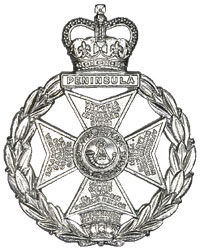Royal Green Jackets
| Royal Green Jackets | |
|---|---|

Royal Green Jackets cap badge
|
|
| Active | 1 January 1966 – 1 February 2007 |
| Allegiance |
|
| Branch |
|
| Type | Rifles |
| Role | Light Infantry |
| Size | 6 battalions |
| Part of | Light Division |
| Garrison/HQ | 1st Battalion – Weeton 2nd Battalion – Bulford |
| Motto(s) | Celer et Audax (Latin: Swift and Bold) |
| March | Quick – Huntsman's Chorus/Italian Song Double Pass – The Road to the Isles |
| Anniversaries | Waterloo (18 June) |
| Commanders | |
| Last Colonel-in-Chief | HM Queen Elizabeth II |
| Last Colonel Commandant | Lieutenant General Nick Parker |
The Royal Green Jackets (RGJ) was an infantry regiment of the British Army, one of two "large regiments" within the Light Division (the other being The Light Infantry).
The Royal Green Jackets was formed on 1 January 1966 by the amalgamation of the three separate regiments of the Green Jackets Brigade: the 1st Green Jackets (43rd and 52nd), the 2nd Green Jackets, the King's Royal Rifle Corps and the 3rd Green Jackets, the Rifle Brigade (Prince Consort's Own).
There were also two Territorial Army battalions made up as follows:
During the 1980s, the battalions were deployed to various parts of Northern Ireland (Operation Banner). The 1st, 2nd and 3rd battalions were also based in West Germany, Osnabrück (1RGJ), Minden (2RGJ) and Celle (3RGJ).
The regiment's greatest loss of life came on 20 July 1982 when seven RGJ bandsmen were killed by a Provisional Irish Republican Army bomb which exploded during a public concert featuring the music from Oliver! to 120 people at the bandstand in Regents Park.
In 1992 1/RGJ was disbanded and 2/RGJ and 3/RGJ renumbered 1/RGJ and 2/RGJ respectively.
After the 1992 reorganisation, the unit was mostly based overseas in Dhekelia, Cyprus and Paderborn, Germany as well as in Northern Ireland and saw action in Bosnia and Kosovo during the Yugoslav Wars. Both battalions returned to the United Kingdom by 2002 and in 2003 the 1st Battalion served on Operation Telic 2 in Iraq.
...
Wikipedia
